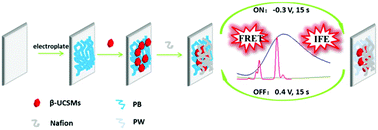A high performance fluorescence switching system triggered electrochemically by Prussian blue with upconversion nanoparticles†
Abstract
A high performance fluorescence switching system triggered electrochemically by Prussian blue with upconversion nanoparticles was proposed. We synthesized a kind of hexagonal monodisperse β-NaYF4:Yb3+,Er3+,Tm3+ upconversion nanoparticle and manipulated the intensity ratio of red emission (at 653 nm) and green emission at (523 and 541 nm) around 2 : 1, in order to match well with the absorption spectrum of Prussian blue. Based on the efficient fluorescence resonance energy transfer and inner-filter effect of the as-synthesized upconversion nanoparticles and Prussian blue, the present fluorescence switching system shows obvious behavior with high fluorescence contrast and good stability. To further extend the application of this system in analysis, sulfite, a kind of important anion in environmental and physiological systems, which could also reduce Prussian blue to Prussian white nanoparticles leading to a decrease of the absorption spectrum, was chosen as the target. And we were able to determine the concentration of sulfite in aqueous solution with a low detection limit and a broad linear relationship.


 Please wait while we load your content...
Please wait while we load your content...